Traditional Frikadellen (German Meatballs)
This post may contain affiliate links. See my disclosure policy.
An authentic Frikadellen recipe, these beloved seasoned German meat patties are also popular in Denmark where they’re known as Frikadeller. They are extremely popular for both mealtimes and picnics because they’re equally delicious either hot or cold! They’ve been a household staple for centuries and their popularity has spread across multiple European countries and beyond!
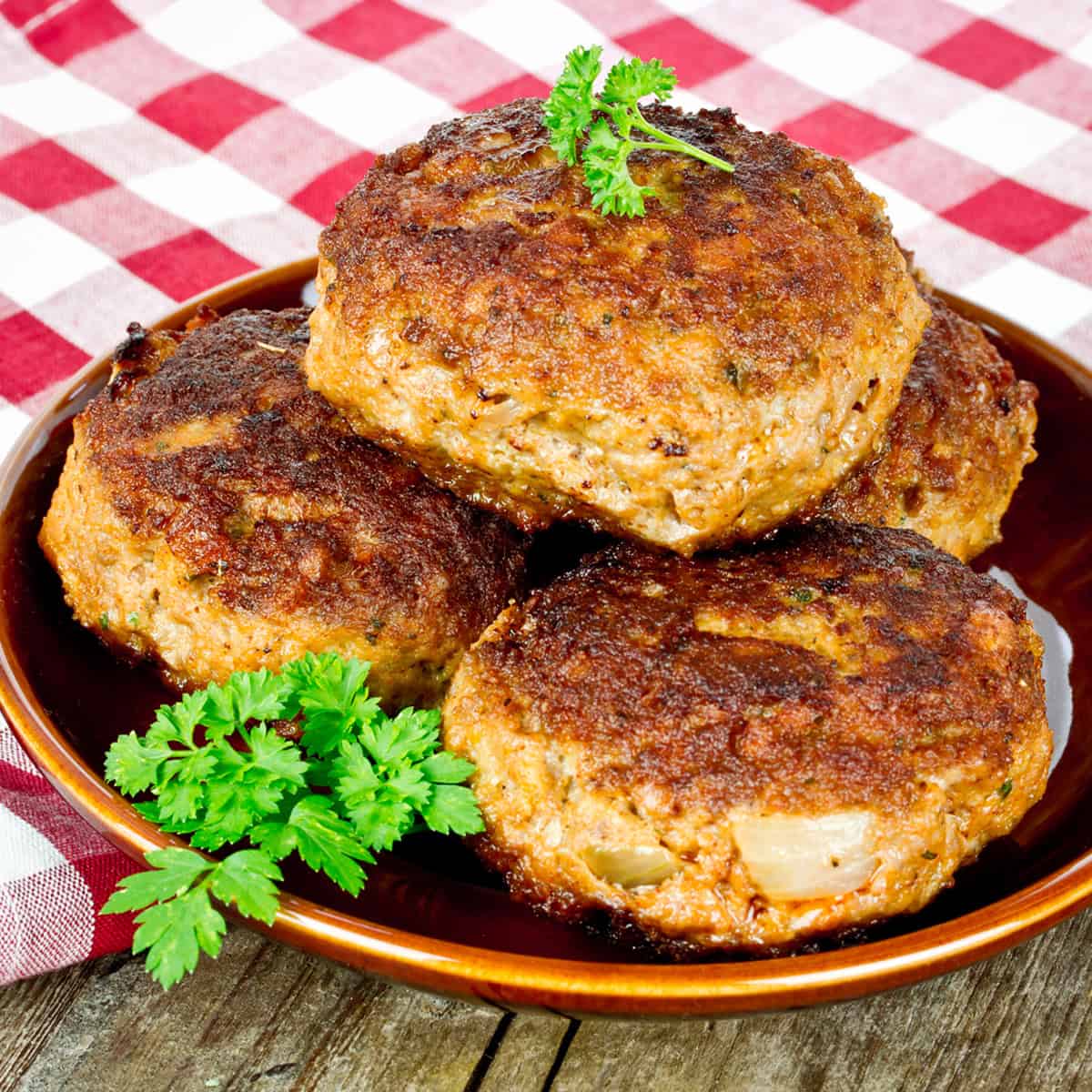
German Hamburgers
Frikadellen, as they’re called in Germany (aka Fleischküchle, Fleischpflanzerl and Buletten), or Frikadeller, as they’re called in Denmark, are seasoned meat patties – you could call them German hamburgers – that are equally good hot or cold and have been popular for both mealtimes and picnics for centuries. This authentic frikadeller recipe captures all the flavor of this popular European favorite!
Where did They Originate?
It’s origin is uncertain but it’s largely attributed to north Germany and Denmark though they have also become very popular throughout Scandinavia, Holland, Poland and other parts of the world. They can be traced back to at least the 18th century in Germany, though they’re almost certainly much older.
Who Invented Hamburgers?
While the the origin of the Frikadelle isn’t entirely clear, what we do know is that the Frikadellen of north Germany, of Hamburg specifically, were the inspiration for what became known as Hamburgers. That’s right, German immigrants from Hamburg took their Frikadellen with them to the United States, eventually someone threw a Frikadelle in between two buns and voilà, the rest is history!
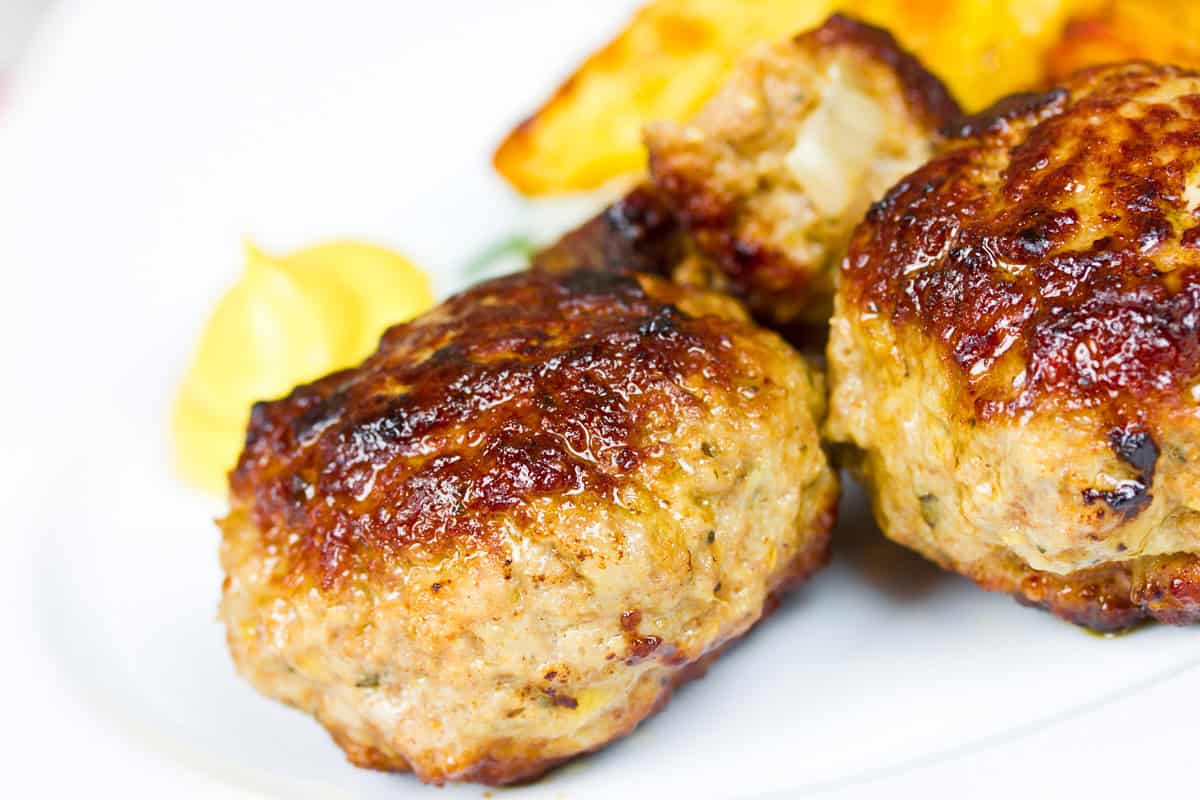
Frikadellen Ingredients
As with almost any “traditional” or “authentic” recipe, there is more than one version. Variations abound depending on the particular region and the particular family tradition. Nevertheless, Frikadellen and Frikadeller generally all have the same core ingredients in common: Ground meat, onions, bread, egg and seasonings. The regional differences vary in the specific seasonings.
In a collection of recipes compiled in 1790 by the mother of German author Theodor Fontanes, the over 200 year-old recipe for Frikadellen was largely the same then as it is today, incorporating ground meat (usually a combination of beef and pork), onions, bread, eggs, parsley and spices. The 1790 recipe calls for two very traditional spices, mace and cardamom. While nutmeg can be substituted, we recommend mace for that traditional old-fashioned German flavor. Likewise marjoram, not oregano, is the traditional herb of choice in Germany and Denmark and really contributes to an authentic flavor.
Traditionally Frikadellen were fried in pork fat or beef fat but today they’re most commonly fried in clarified butter (Butterschmalz) or oil or a combination of both.
Flavor Variations
If you’d like to change up the flavors for something different you can try swapping out the spices in this recipe for any of the following: Curry, chili powder, sun-dried tomatoes, preserved lemon (for a little Moroccan influence, harissa, caraway seeds, fennel, basil, thyme, rosemary, etc. Another variation is to make smaller Frikadellen and skew them onto kabob skewers.
Tips for Achieving the Perfect Frikadellen
- Select ground meat with a good ratio of fat. Do not use extra lean or the Frikadellen will lose a lot of water during cooking and become dry.
- When you press down the balls of meat be sure the width is even throughout the patty for even cooking.
- Moistening your hands with a little water before forming the patties will prevent the meat mixture from sticking to your hands.
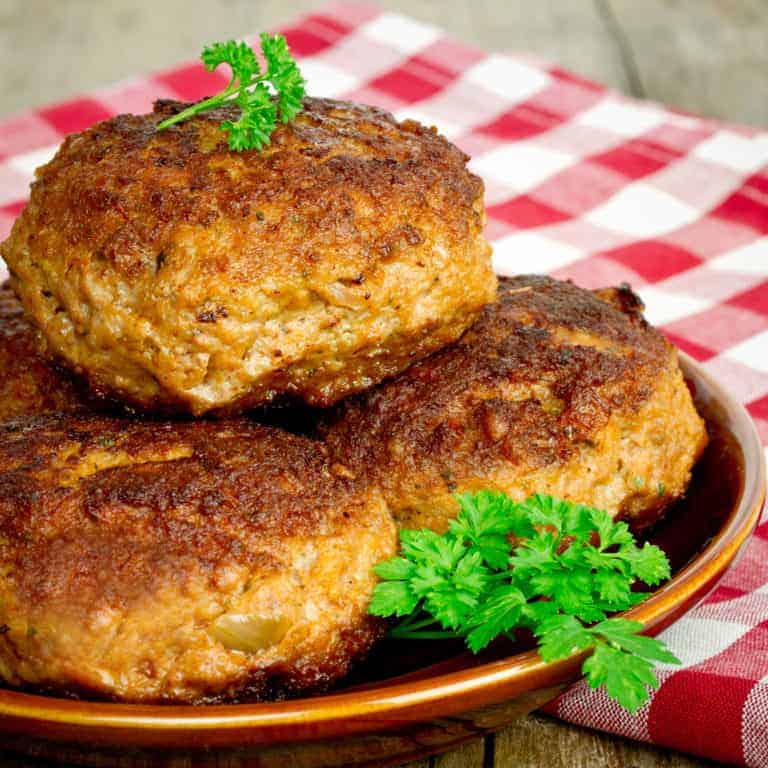
Frikadellen Recipe
Let’s get started!
Break the bread up into small pieces, place them in a small bowl and pour water/milk over them and let them soak for 15 minutes while you’re preparing the other ingredients. Squeeze out any excess liquid.
Heat some oil or butter in a frying and saute the onions until soft and translucent, 5-7 minutes. Add the garlic and cook for another minute.
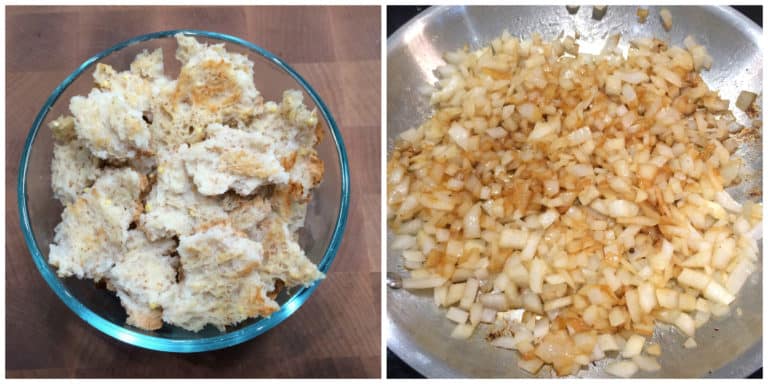
Place all of the ingredients (except for the olive oil and butter) in a large bowl along with the onion mixture and the soaked bread. Use your hands to thoroughly knead the mixture until well blended and the meat is smooth. The more you knead it, the better the results.
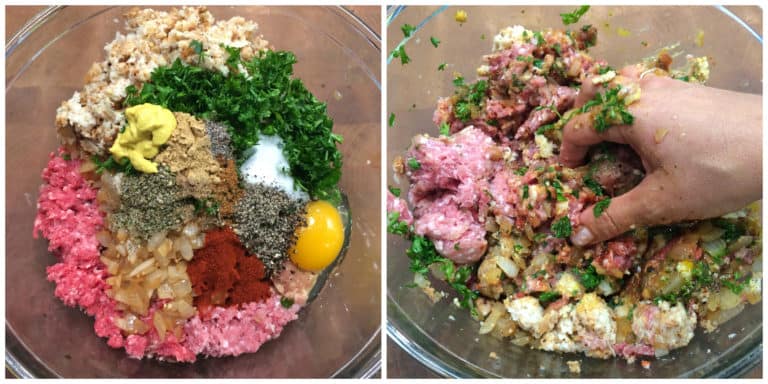
Form the meat mixture into balls according to desired size and slightly flatten them. Cover and chill the patties in the fridge for at least 30 minutes before frying them.
Heat the olive oil and butter in a frying pan. Once hot add the Frikadellen / Frikadeller and fry on both sides on higher heat until nicely browned, then lower the heat and continue to fry over medium heat until cooked through according to desired doneness.
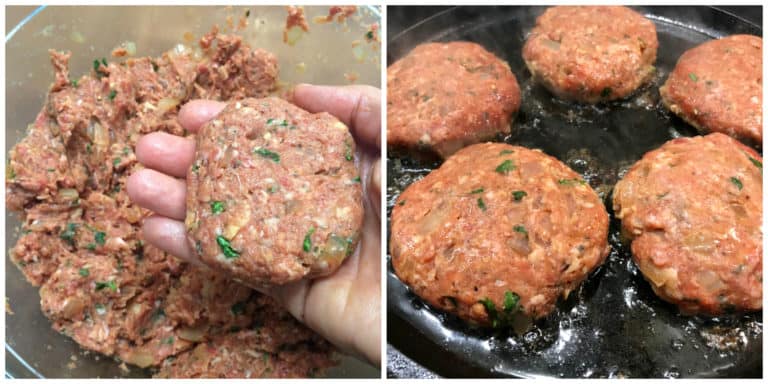
Frikadellen can be enjoyed both hot or cold. To store them let them cool completely and transfer them to an airtight container in the fridge. They can be reheated in the microwave.
Traditionally served with potato salad or a crusty bread roll slathered with mustard.
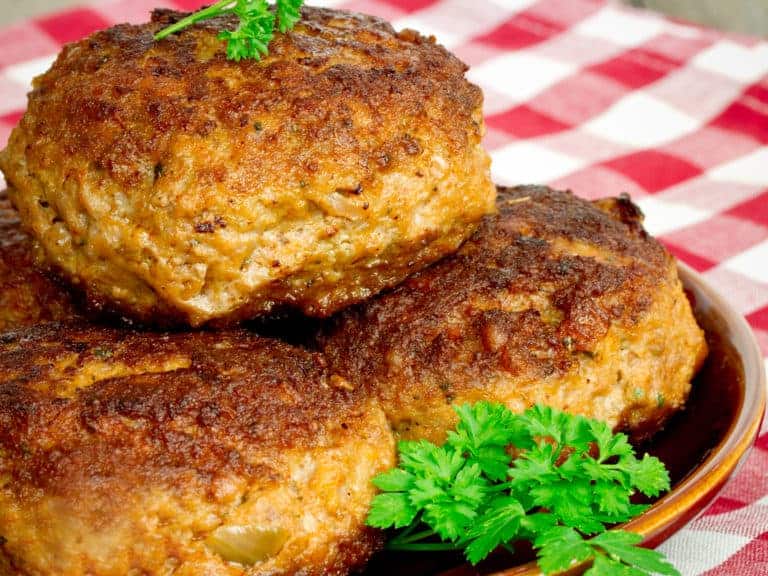
Can Frikadeller Be Made In Advance?
Yes! You can make the meat mixture at least one full day in advance. In fact we recommend it because the flavor only gets better. Cover and refrigerate the meat mixture and then make and fry the patties when you’re ready to use them. Or you can also form the patties in advance and keep them covered and chilled until ready to use. Frikadellen can be eaten hot or cold. They can be reheated in the microwave.
Do They Freeze Well?
Yes they do! They freeze really and will keep for up to 3 months in the freezer. Wrap and store in ziplock freezer bags or airtight containers. Simply thaw and reheat in the microwave, pan or oven.
How to Serve Frikadellen
In Germany Frikadellen are commonly served with potato salad (try my German Potato Salad and Creamy Potato Salad) which is my favorite way to enjoy them, or on a crusty roll slathered with mustard, which makes a great to-go lunch. Many Germans also eat them with mashed potatoes and vegetables, including Rotkohl or Sauerkraut. Some great non-German accompaniments for Frikadellen include Creamy Coleslaw, Freezer Slaw, Broccoli Salad, and Macaroni Salad. In Denmark where they’re known as Frikadeller, they’re commonly eaten on rugbord (Danish rye bread) with pickled red cabbage or slices of pickle. In both countries they’re a popular picnic food because they transport easily and are also good cold.
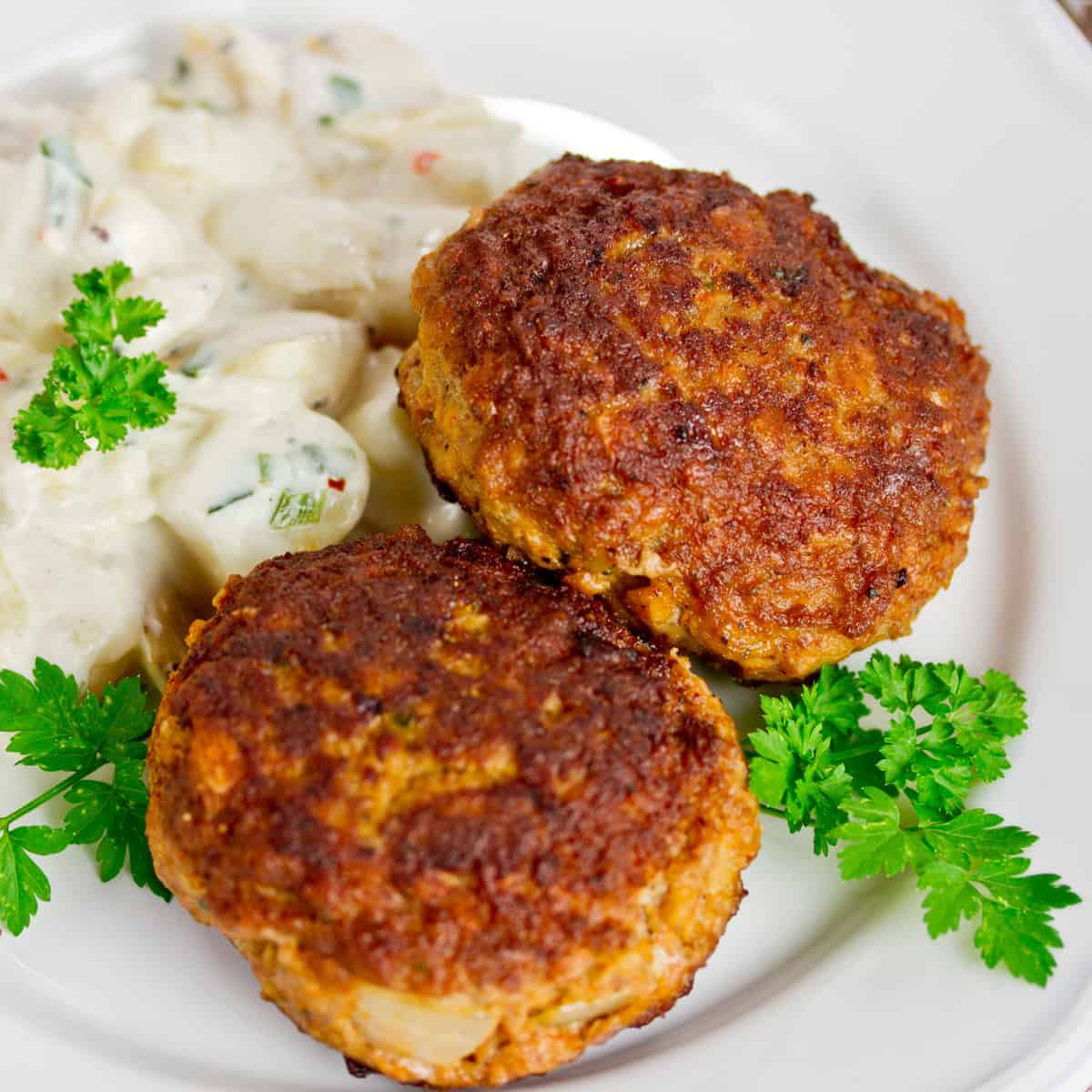
For more traditional German recipes be sure to try my:
- Rouladen
- Sauerbraten
- Maultaschen
- Schnitzel
- Jägerschnitzel
- Schweinshaxe
- Semmelknödel
- German Potato Dumplings
- Königsberger Klopse
- Zwiebelkuchen
- German Sauerkraut Soup
- Käsespätzle
- German Bread (Vollkornbrot)
- Bratwurst
- Currywurst
- Rotkohl
- Sauerkraut
Save This Recipe
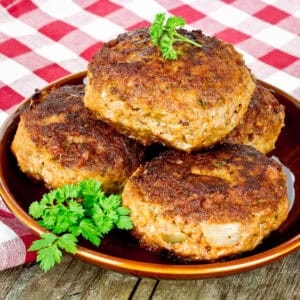
Traditional Frikadellen (German Meatballs)
Ingredients
- 1/2 pound ground beef , 80% recommended for moist Frikadellen; no leaner than 92%
- 1/2 pound ground pork
- 1 medium yellow onion , very finely chopped
- 2 slices slightly stale white bread (about 2 oz or 50 g) (can also use fresh croutons and let them sit out a day); For gluten free use GF bread
- 1/4 cup warm water or milk
- 1 large egg
- 1 clove garlic , minced
- 1/4 cup chopped fresh parsley
- 1 1/2 teaspoons salt
- 3/4 teaspoon freshly ground black pepper
- 1 teaspoon prepared yellow mustard
- 1 teaspoon dried marjoram
- 1 teaspoon sweet Hungarian paprika
- 1/2 teaspoon ground ginger
- 1/4 teaspoon ground mace
- 1/4 teaspoon ground coriander
- 1/8 teaspoon ground cardamom
- 3 tablespoons olive oil
- 1 tablespoon butter
Instructions
- Break the bread up into small pieces, place them in a small bowl and pour water/milk over them and let them soak for 15 minutes while you're preparing the other ingredients. Squeeze out any excess liquid.
- Heat some oil or butter in a frying and saute the onions until soft and translucent, 5-7 minutes. Add the garlic and cook for another minute.
- Place all of the ingredients (except for the olive oil and butter) in a large bowl along with the onion mixture and the soaked bread. Use your hands to thoroughly knead the mixture until well blended and the meat is smooth. The more you knead it, the better the results. Form the meat mixture into balls according to desired size and slightly flatten them. Cover and chill the patties in the fridge for at least 30 minutes.
- Heat the olive oil and butter in a frying pan. Once hot add the Frikadellen / Frikadeller and fry on both sides on higher heat until nicely browned, then lower the heat and continue to fry over medium heat until cooked through according to desired doneness. Traditionally served with potato salad or a crusty bread roll slathered with mustard. See blog post for other serving ideas.
Notes
Nutrition
Originally published on The Daring Gourmet September 16, 2019



















These are brilliant – I first ran into these at our Danish neighbor’s home – so good! Thanks so much for posting this wonderful recipe!
I used to make frikadeller when I was young, my husband’s family is Danish. But now I’m going to follow your recipe and use the spices I haven’t done before. I look forward making frikadellerne again. Thank you!
I hope you enjoy them, Anna, happy cooking! :)
I’ve never heard of these but all of the seasonings sound wonderful!
thats how I make mine, just the way I grew up in Germany
This sounds and looks so flavorful!
Looks like a perfect weeknight dinner! Yum!
What a great idea for dinner or even for a lunch box! These look so tasty!
Sounds splendid and delicious, gotta try this!
This was such a flavorful dish; easily a new family favorite recipe! Looking forward to enjoying this again later this week!
Hmmm it would be a great dinner for my family. I really can’t wait to try. And I like your delicious photos!
Yum! I love trying recipes from other parts of the world!
Wow! These look so good, and while they seem a little like meatloaf, after reading the recipe, I can see the difference and I’m intrigued! I will give these a try, and I think they’d be great made smaller for a buffet table during the holidays too!
I’ve never heard of this, but boy am I dying to try it!
I had to try these, I ran across them and was super curious as I’ve never heard of them, they were amazing. Will be making again soon!
I have never heard of this but I love all of these seasonings! I can’t wait to make this for my family! YUM!
Will be adding these to next week’s meal plan! They look delicious!